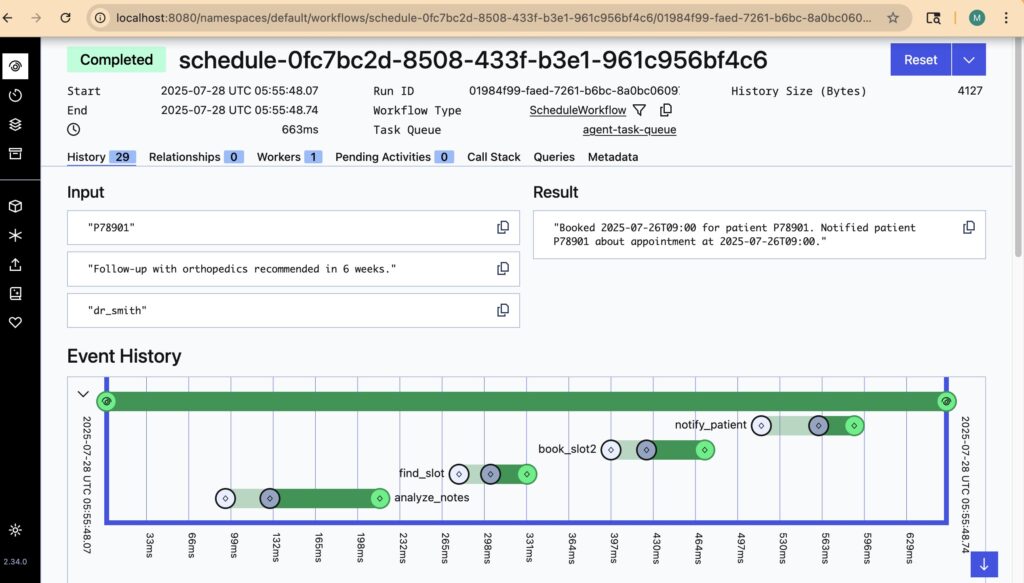By Mahesh Palan
Published: July 2025
🚀 Introduction
Imagine a world where AI reads clinical notes and decides whether a patient needs follow-up — and even books it for them automatically. That’s the vision I had when building my healthcare automation agent. In this blog, I’ll walk you through how I used BERT, PyTorch, Temporal, and FastAPI to create a production-grade AI agent that makes smart decisions from unstructured clinical notes.
💎 Problem Statement
Doctors write tons of free-text notes like:
“Follow-up with orthopedics in 6 weeks.”
or
“No follow-up necessary at this time.”
But how can software understand this and act accordingly?
My goal:
✅ Automatically analyze clinical notes
✅ Predict if a follow-up is needed
✅ Book an appointment
✅ Notify the patient

🛠️ Step 1: Training the Clinical Note Classifier
I used bert-base-uncased via HuggingFace with a simple classifier head.
class FollowUpClassifier(nn.Module):
def __init__(self, num_labels=3):
super().__init__()
self.bert = BertModel.from_pretrained("bert-base-uncased")
self.classifier = nn.Linear(self.bert.config.hidden_size, num_labels)
def forward(self, input_ids, attention_mask):
output = self.bert(input_ids, attention_mask)
pooled_output = output.pooler_output
return self.classifier(pooled_output)Classes: follow_up, conditional, no_follow_up
Saved with:
torch.save(model.state_dict(), "clinical_bert.pt")
tokenizer.save_pretrained("tokenizer/")🧠 Step 2: Predicting Follow-Up
I then wrote a utility to run predictions:
def predict_follow_up(text: str) -> str:
# Load model/tokenizer
# Preprocess text
# Run prediction
# Map to class labels
return label🤖 Step 3: Temporal AI Agent
Temporal lets you define workflows and activities like a business process.
Activities:
@activity.defn
async def analyze_notes(notes: str) -> str:
return predict_follow_up(notes)
@activity.defn
async def find_slot(doctor: str) -> str:
return {"dr_smith": ["2025-07-26T09:00"]}.get(doctor, [None])[0] or "No available slot"
@activity.defn
async def book_slot2(patient_id: str, slot: str) -> str:
return f"Booked {slot} for patient {patient_id}"
@activity.defn
async def notify_patient(patient_id: str, slot: str) -> str:
return f"Notified patient {patient_id} about appointment at {slot}"Workflow:
@workflow.defn
class ScheduleWorkflow:
@workflow.run
async def run(self, patient_id: str, visit_notes: str, doctor: str) -> str:
result = await workflow.execute_activity(analyze_notes, visit_notes)
if result == "No follow-up needed":
return "No follow-up needed."
slot = await workflow.execute_activity(find_slot, doctor)
await workflow.execute_activity(book_slot2, patient_id, slot)
await workflow.execute_activity(notify_patient, patient_id, slot)
return f"Booked and notified for {slot}"🌐 Step 4: FastAPI Integration
I exposed the workflow via HTTP:
@app.post("/agent-schedule", response_model=BookingResponse)
async def schedule_with_agent(event: VisitEvent):
result = await client.execute_workflow(
ScheduleWorkflow.run,
args=[event.patient_id, event.visit_notes, event.doctor],
id=f"schedule-{uuid.uuid4()}",
task_queue="agent-task-queue"
)
return BookingResponse(
patient_id=event.patient_id,
booked="booked" in result.lower(),
slot="2025-07-26T09:00",
message=result
)Test it with:
curl -X POST http://localhost:8000/agent-schedule \
-H "Content-Type: application/json" \
-d '{
"patient_id": "P12345",
"visit_notes": "Patient to follow up with orthopedics in 6 weeks.",
"doctor": "dr_smith"
}'✅ Output
Sample positive result:
{
"patient_id": "P12345",
"booked": true,
"slot": "2025-07-26T09:00",
"message": "Booked 2025-07-26T09:00 for patient P12345..."
}Or if no follow-up needed:
{
"patient_id": "P12345",
"booked": false,
"slot": null,
"message": "No follow-up needed."
}🔍 Learnings
- ✨ Using BERT for unstructured text works well for medical notes
- ⚙️ Temporal gave me robust control over asynchronous workflows
- 📁 FastAPI made this easily accessible
💡 Future Work
- 🚀 Connect to real EHR systems using HL7/FHIR
- 🗒️ Add human review stage for conditional predictions
- 📊 Improve slot logic using real calendar APIs
🤘 Final Thoughts
From model training to automated booking, this project showed how machine learning, workflows, and automation can transform healthcare. Let’s build the future of health — one follow-up at a time.

Leave a Reply